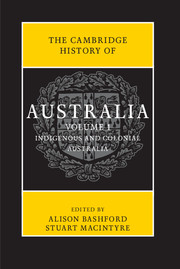Book contents
- Frontmatter
- Contents
- Abbreviations
- List of maps
- List of figures
- List of tables
- Notes on contributors
- Map
- Preface
- Introduction
- PART I
- 1 The past 50,000 years: an archaeological view
- 2 Newcomers, c. 1600–1800
- 3 Convict transportation in global context, c. 1700–88
- 4 The early colonial presence, 1788–1822
- 5 Expansion, 1820–50
- 6 The advent of self-government, 1840s–90
- 7 The gold rushes of the 1850s
- 8 Colonial states and civil society, 1860–90
- 9 Rethinking the 1890s
- 10 Making the federal Commonwealth, 1890–1901
- PART II
- Further reading
- Chronology
- Index
- Frontmatter
- Contents
- Abbreviations
- List of maps
- List of figures
- List of tables
- Notes on contributors
- Map
- Preface
- Introduction
- PART I
- PART II
- Further reading
- Chronology
- Index
1 - The past 50,000 years: an archaeological view
from PART I
Published online by Cambridge University Press: 05 November 2013
- Frontmatter
- Contents
- Abbreviations
- List of maps
- List of figures
- List of tables
- Notes on contributors
- Map
- Preface
- Introduction
- PART I
- 1 The past 50,000 years: an archaeological view
- 2 Newcomers, c. 1600–1800
- 3 Convict transportation in global context, c. 1700–88
- 4 The early colonial presence, 1788–1822
- 5 Expansion, 1820–50
- 6 The advent of self-government, 1840s–90
- 7 The gold rushes of the 1850s
- 8 Colonial states and civil society, 1860–90
- 9 Rethinking the 1890s
- 10 Making the federal Commonwealth, 1890–1901
- PART II
- Further reading
- Chronology
- Index
- Frontmatter
- Contents
- Abbreviations
- List of maps
- List of figures
- List of tables
- Notes on contributors
- Map
- Preface
- Introduction
- PART I
- PART II
- Further reading
- Chronology
- Index
Summary
The ‘beginnings’ of Australian history are always difficult to determine. In addition to Indigenous systems of knowledge with their own epistemologies, understanding ancient Australia involves the disciplines of archaeology, anthropology and linguistics, as well as history. These disciplines developed out of earlier forms of knowledge whereby European explorers, settlers, naturalists, ethnologists, antiquarians and collectors sought to ascertain the Australian past.
In the absence of written records, archaeologists have played a leading role in reconstructing this past. Initially relying on the stratified sequence of excavated material to produce a relative chronology of cultural change, from the 1950s they were able to employ new methods of dating their discoveries – first radiocarbon dating and later electron spin resonance and luminescence methods. During the 1950s it was commonly believed that people had occupied Australia no earlier than 10,000 years ago, during the last Ice Age, and it was only in 1962 that radiocarbon dates exceeded 10,000 years. The earliest known occupation stretched to 20,000 years ago by 1965, 30,000 years by 1969 and 40,000 by 1973.
Within this enlarged chronology, a rapid occupation was posited along with a narrative of adaptation to diverse environments and growing technological sophistication. These findings coincided with demands of Aboriginal and Torres Strait Islander people for self-determination and a growing non-Indigenous appreciation of Indigenous cultures. The common view that Australia had only an abbreviated history gave way to a new awareness of a deep past. Popular interest was served by surveys such as The Prehistory of Australia (1969) by the pioneer archaeologist John Mulvaney, and Josephine Flood's The Archaeology of the Dreamtime (1983). Some historians sought to explore the implications of this extended human occupation, among them Geoffrey Blainey in The Triumph of the Nomads (1975) and Noel Butlin in Economics and the Dreamtime (1993). Yet the increasingly technical nature of archaeology has forged new partnerships with natural history and environmental sciences.
- Type
- Chapter
- Information
- The Cambridge History of Australia , pp. 17 - 42Publisher: Cambridge University PressPrint publication year: 2013
- 9
- Cited by



